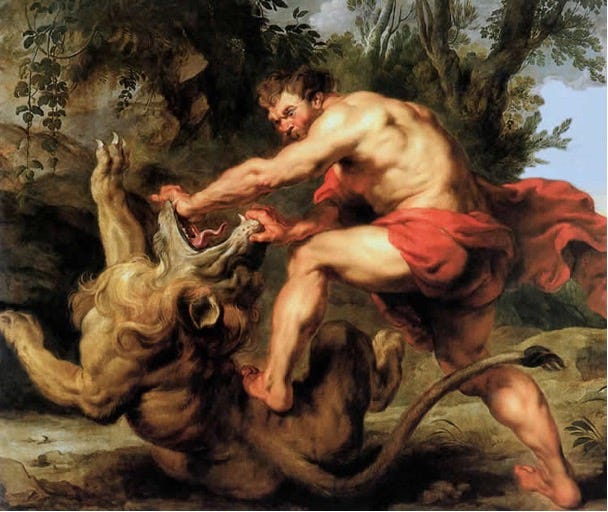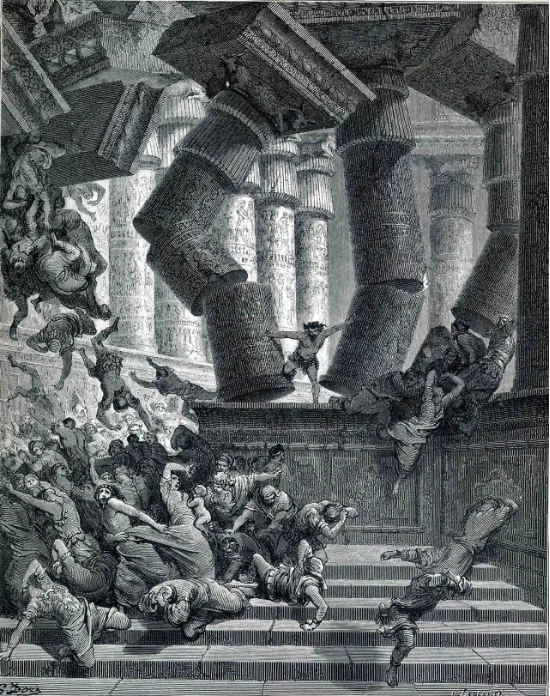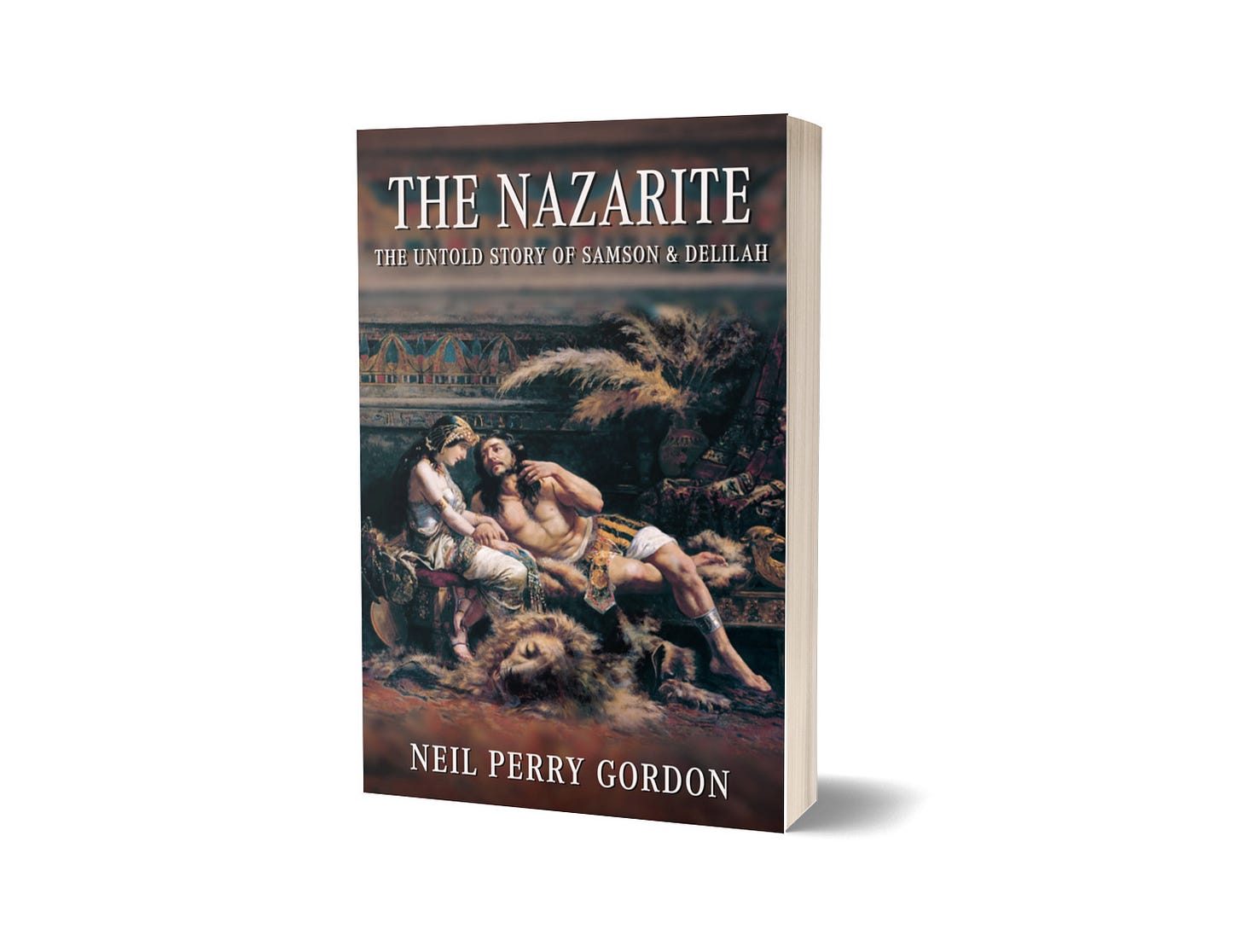In this collection, I explore the timeless biblical tale of Samson, Delilah, and the Lion through the lens of five captivating artworks. Each piece offers a unique artistic interpretation of this gripping narrative, inviting us to delve into the themes of strength, betrayal, and the consequences of human frailty. From the masterful brushwork of Peter Paul Rubens to the evocative imagery of Gustave Doré, these artworks capture the essence of this iconic story, leaving an indelible mark on our visual imagination. Join me on this journey as we delve into the artistic interpretations that breathe life into the ancient tale of Samson, Delilah, and the Lion.
"Samson and the Lion" is a powerful and visually striking painting by the renowned Flemish artist Peter Paul Rubens. Completed around 1615, this masterpiece captures a pivotal moment from the biblical story of Samson, showcasing Rubens' extraordinary talent for conveying strength, dynamism, and emotion.
In the painting, Samson, portrayed as a robust and muscular figure, is violently struggling with a ferocious lion. The lion, with its teeth, bared and claws extended, emGod'ss raw power and aggression. Samson's physical prowess is evident as he grapples with the formidable beast, his muscular arms and sinewy body strained with exertion.
Rubens expertly captures the drama of the encounter through his masterful use of color, light, and motion. The composition is filled with dynamic energy, with swirling brushstrokes and bold contrasts of light and shadow, adding to the scene's intensity. The rich earthy tones and vibrant hues enhance the sense of drama and capture the viewer's attention.
The painting not only showcases Rubens' technical mastery but also conveys the underlying themes of the Samson narrative. It speaks GodGod's extraordinary strength bestowed upon Samson as he uses his might to combat and conquer the lion, symbolizing the triumph of good over evil.
"Samson and the Lion" exemplifies Rubens' ability to depict complex narratives with vivid realism, emotional depth, and theatrical flair. It remains an iconic work of art that continues to captivate viewers, inviting them to contemplate the remarkable tale of Samson's strength and the eternal struggle between forces of darkness and light.
"Samson and Delilah" by Erte is a stunning serigraph that captures the essence of this timeless biblical tale. Created by the renowned artist in his signature Art Deco style, this artwork showcases Erte's mastery of form, line, and composition.
In the serigraph, Delilah, portrayed with elegance and allure, stands before the influential figure of Samson. Her flowing gown and intricate headdress exude a sense of opulence and sophistication. With a seductive yet calculating expression, she gazes at Samson, who appears strong and vulnerable.
Erte's precise and intricate detailing brings the scene to life, from the intricate patterns adorning Delilah's attire to the strength evident in Samson's muscular form. The interplay of bold lines and contrasting colors creates a visually striking composition that draws the viewer into the narrative.
The serigraph captures the moment of betrayal and evokes a sense of tension and dramatic anticipation. It invites viewers to ponder the complex dynamics between the two characters and contemplate the themes of power, trust, and the consequences of deception.
"Samson and Delilah" by Erte is a testament to the artist's ability to merge classical themes with his distinct Art Deco style. It remains an enduring artwork that captures the intrigue and allure of this iconic biblical story while showcasing Erte's unique artistic vision and craftsmanship.
"Samson and Delilah" by Peter Paul Rubens is another captivating masterpiece depicting a pivotal moment from the biblical story. Created around 1609-1610, this iconic painting showcases Rubens' exceptional talent for narrative and emotional expression.
In a dimly lit chamber, Delilah sits beside a slumbering Samson, delicately cutting his source of strength, his long locks. Delilah's face reveals allure, betrayal, and anticipation, while Samson lies unaware and peaceful. The interplay of light and shadow intensifies the emotional tension, bringing the scene to life.
Rubens' brushwork captures their physical presence and emotional turmoil, enhanced by rich colors and intricate details. The painting delves into themes of seduction, betrayal, and the consequences of misplaced trust, inviting viewers to reflect on the allure of temptation and its tragic outcomes.
With its profound storytelling and emotional resonance, "Samson and Delilah" remains one of Rubens' most renowned works, captivating audiences and prompting contemplation of human complexities and the dangers of misplaced trust.
"Samson and Delilah" by Jose Etxenagusia Errazkin, created in 1887, is an oil on canvas artwork that portrays the iconic biblical story of Samson and Delilah. The painting captures the pivotal moment when Delilah, a woman of incredible beauty and cunning, betrays Samson, a tremendous strength and power figure.
In the composition, Delilah is depicted seated, her gaze fixed upon Samson, who lies with his head in her lap. Delilah's expression is intrigue and deceit, while Samson's face reveals vulnerability and unawareness of the impending betrayal. The artist's attention to detail is evident in the rendering of their facial features and expressions, bringing the emotional intensity of the scene to life.
The play of light and shadow adds depth and drama to the painting. Illuminated areas highlight the delicate features of Delilah and cast a soft glow on Samson's face, emphasizing the contrast between the characters. The artist's skillful brushwork and use of color create a harmonious and evocative composition.
"Samson and Delilah" by Jose Etxenagusia Errazkin capture the timeless themes of temptation, betrayal, and the fragility of human nature. The artwork invites viewers to contemplate the consequences of succumbing to weakness and the ultimate powerlessness of even the most assertive individuals.
"Samson" by Gustave Doré is a captivating illustration that brings to life the biblical character of Samson in his moment of immense strength and triumph. Created by the renowned French artist in the 19th century, this black-and-white engraving showcases Doré's exceptional talent for capturing the grandeur and drama of biblical narratives.
In the artwork, Samson is depicted as a colossal figure, his muscular form towering over the scene. With his long hair flowing, he stands among the remnants of a collapsed structure, symbolizing his extraordinary feat of strength. The intensity of his expression and the strain visible in his muscles convey his immense power and determination.
Doré's intricate etching technique brings depth and texture to the artwork. The meticulous detailing of Samson's physique, the architectural elements, and the surrounding debris showcase the artist's attention to anatomical accuracy and atmospheric rendering.
Light and shadow play a crucial role in the composition, enhancing the scene's dramatic impact. Doré skillfully employs shading and cross-hatching to create contrasts, emphasizing the contours of Samson's muscular form and adding depth and dimension to the overall composition.
"Samson" by Gustave Doré continues to captivate audiences with its dramatic portrayal of the biblical hero, offering viewers a glimpse into the extraordinary strength and determination that defined his character.
THE NAZARITE - A NOVELLA
The Nazarite by Neil Perry Gordon spins the tale of the great strongman and biblical hero—Samson. He could slay a lion with his bare hands, defeat an army of one thousand strong with the jawbone of an ass, lift the mighty Gates of Gaza, and many more captivating triumphs. It’s a fantastic story of incredible and outrageous feats, accompanied by an intriguing love affair between Samson the Israelite and Delilah the Philistine. It was this compelling relationship that has raised many brows and questions.
Why did Samson share sacred secret with the vixen—Delilah? A mystery so dear that his life depended upon keeping it private. Yet he confides in Delilah and, by doing so, is taken captive by his people’s existential enemy. His eyes are gored out, and he is sentenced to be sacrificed to the Philistine god—Dagon.
Can we imagine Delilah, armed with her exquisite beauty and cunning deceit, enticing the lustful Samson by luring him beyond their intimacy? Why else would the Nazarite give up the key to his great strength unless drawn by forbidden, erotic desires?
The novella is written through the eyes of Samson and a Philistine scribe—Mizar, who’s given the task of writing upon parchment the events of Samson's incredible life.










